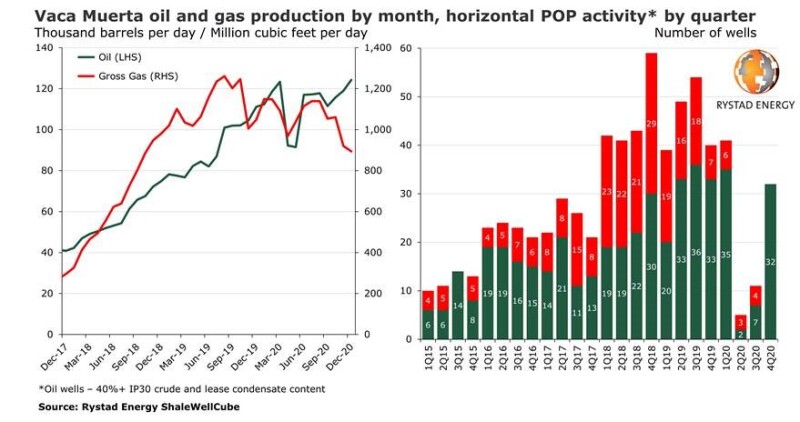Oil production from the Vaca Muerta Shale has surpassed the record level prior to the crash nearly a year ago, as operators in the Argentine formation belatedly move toward full development mode.
Rystad reported production hit 124,000 B/D in December as drilling and completions work came back in the oil window at the eastern edge of the formation. Farther west in the gas window, they are still waiting for a comeback.
“Oil wells put on production rebounded sharply in November and December, pushing the new oil well count to an average of about 11 wells per month," said Artem Abramov, head of shale research at Rystad Energy.
The sources of the growth were international companies, led by an independent, Vista, producing 15,000 B/D, and Shell at 13,000 B/D.
“As of December 2020, YPF is yet to return to its pre-COVID-19 Vaca Muerta oil production record, and the play’s recovery was therefore mainly driven by producers with aggressive capital programs planned for 2020,” the report said.

Oil output has proved resilient despite economic obstacles which have depressed gas development which is already under negative pressure because gas use is down during the country’s summer months.
The rising price of oil—Brent crude was trading near $59/bbl on Wednesday—is a plus for development, but local factors play a large role.
Development drilling is overdue. International companies got a later start than YPF, the Argentine oil company that pioneered the play. They are just now ramping up for development drilling in a play where basics, such as horizontal drilling rigs and sand mines, were lacking a few years ago.
“Vaca Muerta’s oil development is only now entering a manufacturing mode,” the report said. There has been “a 6–7% improvement in most well productivity metrics for Vaca Muerta oil wells between 2019 and 2020.”
The report noted that companies are still benefiting from increasing the sand and fluid used per lateral foot and reducing well costs significantly by drilling faster. US shale producers have wrung most of the gains out of those options.
Based on Rystad’s data and analytics program, the breakeven price for oil in the Vaca Muerta is in line with the “best US tight-oil plays.”
“The estimated ultimate recovery (EUR, oil and gas) range for recent Vaca Muerta completions is comparable to what we are seeing in the US Midland and Eagle Ford plays, while extremely low gas-to-oil ratios—even lower than the Bakken—mean Vaca Muerta wells are expected to produce more oil over the life of the well."
There is another side to the story in the Vaca Muerta, which undergoes a sharp transition from oil in its eastern side to dry gas on its western half that extends to the border of Chile.
Despite an enormous amount of gas in the ground there and elsewhere in Argentina, gas production has not fully recovered from a sharp drop last year when COVID-19 restrictions reduced demand.
In October, the Argentine president, President Alberto Fernández, announced rules to bring back an an incentive price for gas—an increase from $2 to $3.50—and the elimination of an 8% tax on oil exports, according to a report from S&P Platts. He also promised to loosen limits on currency conversions that make it hard to pay for oil technology imports, and profit from exports should boost gas output this year.
Among those who took up that offer was Vista. It announced a 4-year contract to sell 30.4 MMcf/D for $3.29/MMBtu. In exchange it “committed to invest approximately $45 million during the 4 years of the Plan to Promote Argentine Natural Gas Production.”


